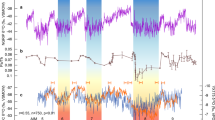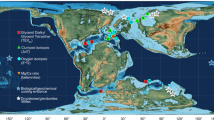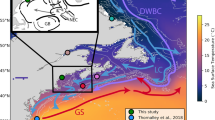Abstract
The global temperature evolution during the Holocene is poorly known. Whereas proxy data suggest that warm conditions prevailed in the Early to mid-Holocene with subsequent cooling, model reconstructions show long-term warming associated with ice-sheet retreat and rising greenhouse gas concentrations. One reason for this contradiction could be the under-representation of indicators for winter climate in current global proxy reconstructions. Here we present records of carbon and oxygen isotopes from two U–Th-dated stalagmites from Kinderlinskaya Cave in the southern Ural Mountains that document warming during the winter season from 11,700 years ago to the present. Our data are in line with the global Holocene temperature evolution reconstructed from transient model simulations. We interpret Eurasian winter warming during the Holocene as a response to the retreat of Northern Hemisphere ice sheets until about 7,000 years ago, and to rising atmospheric greenhouse gas concentrations and winter insolation thereafter. We attribute negative δ18O anomalies 11,000 and 8,200 years ago to enhanced meltwater forcing of North Atlantic Ocean circulation, and a rapid decline of δ13C during the Early Holocene with stabilization after about 10,000 years ago to afforestation at our study site. We conclude that winter climate dynamics dominated Holocene temperature evolution in the continental interior of Eurasia, in contrast to regions more proximal to the ocean.
This is a preview of subscription content, access via your institution
Access options
Access Nature and 54 other Nature Portfolio journals
Get Nature+, our best-value online-access subscription
$29.99 / 30 days
cancel any time
Subscribe to this journal
Receive 12 print issues and online access
$259.00 per year
only $21.58 per issue
Buy this article
- Purchase on Springer Link
- Instant access to full article PDF
Prices may be subject to local taxes which are calculated during checkout




Similar content being viewed by others
References
Alder, J. R. & Hostetler, S. W. Global climate simulations at 3000-year intervals for the last 21,000 years with the GENMOM coupled atmosphere–ocean model. Clim. Past 11, 449–471 (2015).
Liu, Z. et al. The Holocene temperature conundrum. Proc. Natl Acad. Sci. USA 111, E3501–E3505 (2014).
Timm, O. & Timmermann, A. Simulation of the last 21 000 years using accelerated transient boundary conditions. J. Clim. 20, 4377–4401 (2007).
Marcott, S. A., Shakun, J. D., Clark, P. U. & Mix, A. C. A reconstruction of regional and global temperature for the past 11,300 years. Science 339, 1198–1201 (2013).
Mayewski, P. A. et al. Holocene climate variability. Quat. Res. 62, 243–255 (2004).
Sejrup, H. P. et al. North Atlantic-Fennoscandian Holocene climate trends and mechanisms. Quat. Sci. Rev. 147, 365–378 (2016).
Samartin, S. et al. Warm Mediterranean mid-Holocene summers inferred from fossil midge assemblages. Nat. Geosci. 10, 207–212 (2017).
Klemm, J. et al. A pollen-climate transfer function from the tundra and taiga vegetation in Arctic Siberia and its applicability to a Holocene record. Palaeogeogr. Palaeoclimatol. Palaeoecol. 386, 702–713 (2013).
Jiang, D., Lang, X., Tian, Z. & Wang, T. Considerable model–data mismatch in temperature over China during the Mid-Holocene: results of PMIP simulations. J. Clim. 25, 4135–4153 (2012).
Davis, B. A. S. & Brewer, S. Orbital forcing and role of the latitudinal insolation/temperature gradient. Clim. Dynam. 32, 143–165 (2009).
Bartlein, P. J. et al. Pollen-based continental climate reconstructions at 6 and 21 ka: a global synthesis. Clim. Dynam. 37, 775–802 (2010).
Meyer, H. et al. Long-term winter warming trend in the Siberian Arctic during the mid- to late Holocene. Nat. Geosci. 8, 122–125 (2015).
Coplen, T. B. Calibration of the calcite–water oxygen-isotope geothermometer at Devils Hole, Nevada, a natural laboratory. Geochim. Cosmochim. Acta 71, 3948–3957 (2007).
Kurita, N. Modern isotope climatology of Russia: a first assessment. J. Geophys. Res. 109, D03102 (2004).
Velichko, A. A. et al. Climate changes in East Europe and Siberia at the Late glacial–holocene transition. Quat. Int. 91, 75–99 (2002).
Golovanova, I. V., Sal’manova, R. Y. & Demezhko, D. Y. Climate reconstruction in the Urals from geothermal data. Russ. Geol. Geophys. 53, 1366–1373 (2012).
Demezhko, D. Y. & Shchapov, V. A. 80,000 Years ground surface temperature history inferred from the temperature-depth log measured in the superdeep hole SG-4 (the Urals, Russia). Glob. Planet. Change 29, 219–230 (2001).
Danukalova, G. et al. Biostratigraphy of the Late Upper Pleistocene (Upper Neopleistocene) to Holocene deposits of the Belaya River valley (Southern Urals, Russia). Quat. Int. 231, 28–43 (2011).
Guan, J. et al. Understanding the temporal slope of the temperature-water isotope relation during the deglaciation using isoCAM3: the slope equation. J. Geophys. Res. 121, 342–354 (2016).
Wanner, H., Solomina, O., Grosjean, M., Ritz, S. P. & Jetel, M. Structure and origin of Holocene cold events. Quat. Sci. Rev. 30, 3109–3123 (2011).
Novenko, E., Olchev, A., Desherevskaya, O. & Zuganova, I. Paleoclimatic reconstructions for the south of Valdai Hills (European Russia) as paleo-analogs of possible regional vegetation changes under global warming. Environ. Res. Lett. 4, 045016 (2009).
Wanner, H. et al. Mid- to Late Holocene climate change: an overview. Quat. Sci. Rev. 27, 1791–1828 (2008).
Davis, B. A. S., Brewer, S., Stevenson, A. C. & Guiot, J. The temperature of Europe during the Holocene reconstructed from pollen data. Quat. Sci. Rev. 22, 1701–1716 (2003).
Mauri, A., Davis, B. A. S., Collins, P. M. & Kaplan, J. O. The climate of Europe during the Holocene: a gridded pollen-based reconstruction and its multi-proxy evaluation. Quat. Sci. Rev. 112, 109–127 (2015).
Tarasov, P. et al. Vegetation and climate dynamics during the Holocene and Eemian interglacials derived from Lake Baikal pollen records. Palaeogeogr. Palaeoclimatol. Palaeoecol. 252, 440–457 (2007).
Leroy, S. A. G., López-Merino, L., Tudryn, A., Chalié, F. & Gasse, F. Late Pleistocene and Holocene palaeoenvironments in and around the middle Caspian basin as reconstructed from a deep-sea core. Quat. Sci. Rev. 101, 91–110 (2014).
Constantin, S., Bojar, A.-V., Lauritzen, S.-E. & Lundberg, J. Holocene and Late Pleistocene climate in the sub-Mediterranean continental environment: a speleothem record from Poleva Cave (Southern Carpathians, Romania). Palaeogeogr. Palaeoclimatol. Palaeoecol. 243, 322–338 (2007).
Drăguşin, V. et al. Constraining Holocene hydrological changes in the Carpathian–Balkan region using speleothem δ18O and pollen-based temperature reconstructions. Clim. Past 10, 1363–1380 (2014).
Göktürk, O. M. et al. Climate on the southern Black Sea coast during the Holocene: implications from the Sofular Cave record. Quat. Sci. Rev. 30, 2433–2445 (2011).
Rimbu, N., Lohmann, G., Lorenz, S. J., Kim, J. H. & Schneider, R. R. Holocene climate variability as derived from alkenone sea surface temperature and coupled ocean–atmosphere model experiments. Clim. Dynam. 23, 215–227 (2004).
Luthi, D. et al. High-resolution carbon dioxide concentration record 650,000–800,000 years before present. Nature 453, 379–382 (2008).
Dyke, A. S. Developments in Quaternary Science Vol. 2, 373–424 (2004).
Brayshaw, D. J., Hoskins, B. & Black, E. Some physical drivers of changes in the winter storm tracks over the North Atlantic and Mediterranean during the Holocene. Phil. Trans. R. Soc. A 368, 5185–5223 (2010).
Jin, L., Chen, F., Morrill, C., Otto-Bliesner, B. L. & Rosenbloom, N. Causes of early Holocene desertification in arid central Asia. Clim. Dynam. 38, 1577–1591 (2011).
Harrison, S. P., Prentice, I. C. & Bartlein, P. J. Influence of insolation and glaciation on atmospheric circulation in the North Atlantic sector: implications of general circulation model experiments for the Late Quaternary climatology of Europe. Quat. Sci. Rev. 11, 283–299 (1992).
Siegert, M. Numerical reconstructions of the Eurasian Ice Sheet and climate during the Late Weichselian. Quat. Sci. Rev. 23, 1273–1283 (2004).
Anderson, P. M. et al. Climatic changes of the last 18,000 years: observations and model simulations. Science 241, 1043–1052 (1988).
Carlson, A. E. et al. Rapid early Holocene deglaciation of the Laurentide ice sheet. Nat. Geosci. 1, 620–624 (2008).
Vinther, B. M. et al. Synchronizing ice cores from the Renland and Agassiz ice caps to the Greenland Ice Core Chronology. J. Geophys. Res. 113, D08115 (2008).
Ortega, P. et al. Characterizing atmospheric circulation signals in Greenland ice cores: insights from a weather regime approach. Clim. Dynam. 43, 2585–2605 (2014).
Gajewski, K. Quantitative reconstruction of Holocene temperatures across the Canadian Arctic and Greenland. Glob. Planet. Change 128, 14–23 (2015).
Briner, J. P. et al. Holocene climate change in Arctic Canada and Greenland. Quat. Sci. Rev. 147, 340–364 (2016).
Kutzbach, J. E., Vavrus, S. J., Ruddiman, W. F. & Philippon-Berthier, G. Comparisons of atmosphere–ocean simulations of greenhouse gas-induced climate change for pre-industrial and hypothetical ‘no-anthropogenic’ radiative forcing, relative to present day. Holocene 21, 793–801 (2011).
Carlson, A. E. & Clark, P. U. Ice sheet sources of sea level rise and freshwater discharge during the last deglaciation. Rev. Geophys. 50, RG4007 (2012).
Wiersma, A. P. & Renssen, H. Model–data comparison for the 8.2 ka BP event: confirmation of a forcing mechanism by catastrophic drainage of Laurentide Lakes. Quat. Sci. Rev. 25, 63–88 (2006).
Nesje, A., Dahl, S. O. & Bakke, J. Were abrupt Lateglacial and early-Holocene climatic changes in northwest Europe linked to freshwater outbursts to the North Atlantic and Arctic Oceans? Holocene 14, 299–310 (2004).
Hald, M. et al. Variations in temperature and extent of Atlantic Water in the northern North Atlantic during the Holocene. Quat. Sci. Rev. 26, 3423–3440 (2007).
Lewis, C. F. M., Miller, A. A. L., Levac, E., Piper, D. J. W. & Sonnichsen, G. V. Lake Agassiz outburst age and routing by Labrador Current and the 8.2 cal ka cold event. Quat. Int. 260, 83–97 (2012).
Cheng, H. et al. Improvements in 230Th dating, 230Th and 234U half-life values, and U–Th isotopic measurements by multi-collector inductively coupled plasma mass spectrometry. Earth Planet. Sci. Lett. 371–372, 82–91 (2013).
Fohlmeister, J. A statistical approach to construct composite climate records of dated archives. Quat. Geochronol. 14, 48–56 (2012).
Dreybrodt, W., Hansen, M. & Scholz, D. Processes affecting the stable isotope composition of calcite during precipitation on the surface of stalagmites: laboratory experiments investigating the isotope exchange between DIC in the solution layer on top of a speleothem and the CO2 of the cave atmosphere. Geochim. Cosmochim. Acta 174, 247–262 (2016).
Deininger, M., Fohlmeister, J., Scholz, D. & Mangini, A. Isotope disequilibrium effects: the influence of evaporation and ventilation effects on the carbon and oxygen isotope composition of speleothems—a model approach. Geochim. Cosmochim. Acta 96, 57–79 (2012).
Acknowledgements
We are grateful to N. Rychagova, the Ufa Speleo Club, and P. Yakubson for cave access and assistance with stalagmite sampling. We thank J. Alder, O. Timm, Z. Liu and R. Smith for providing palaeoclimate model data. Fieldwork and cave monitoring equipment were funded by grants to J.L.B. from the National Speleological Society, Geological Society of America, William J. Fulbright Foundation, and the UNLV Graduate and Professional Student Association. Stable-isotope analyses were supported by NSF grant EAR-0521196 to M.S.L. and facilities support by UNLV, and by EAR-0326902 to UNM.
Author information
Authors and Affiliations
Contributions
J.L.B., M.S.L. and O.C. designed the study; J.L.B. and O.C. completed the fieldwork. J.L.B. and M.S.L. performed stable-isotope analyses; Y.A. and V.J.P. performed U-series dating. J.L.B. wrote the first draft of the manuscript. All authors contributed to data interpretation and the preparation of the final manuscript.
Corresponding author
Ethics declarations
Competing interests
The authors declare no competing financial interests.
Supplementary information
Supplementary Information
Supplementary Information (PDF 11597 kb)
Rights and permissions
About this article
Cite this article
Baker, J., Lachniet, M., Chervyatsova, O. et al. Holocene warming in western continental Eurasia driven by glacial retreat and greenhouse forcing. Nature Geosci 10, 430–435 (2017). https://doi.org/10.1038/ngeo2953
Received:
Accepted:
Published:
Issue Date:
DOI: https://doi.org/10.1038/ngeo2953
This article is cited by
-
Western Caucasus regional hydroclimate controlled by cold-season temperature variability since the Last Glacial Maximum
Communications Earth & Environment (2024)
-
Spatial patterns of Holocene temperature changes over mid-latitude Eurasia
Nature Communications (2024)
-
Revisiting the Holocene global temperature conundrum
Nature (2023)
-
Prehistoric population expansion in Central Asia promoted by the Altai Holocene Climatic Optimum
Nature Communications (2023)
-
Holocene temperature variation recorded by branched glycerol dialkyl glycerol tetraethers in a loess-paleosol sequence from the north-eastern Tibetan Plateau
Frontiers of Earth Science (2023)



